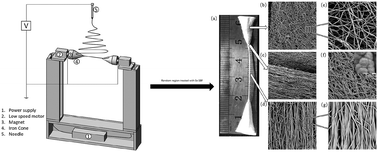Osteogenic and tenogenic induction of hBMSCs by an integrated nanofibrous scaffold with chemical and structural mimicry of the bone–ligament connection†
Abstract
A novel electrospinning nanofiber collecting device was designed and utilized to fabricate an integrated poly(ε-caprolactone) (PCL) nanofibrous scaffold with a “random–aligned–random” structure. The random region of the scaffold was subsequently soaked in a 5× simulated body fluid (5× SBF) to coat the surface of the scaffold with a mineral layer. The region-specific composition and structure thus mimic the bone–ligament connection. The ultimate tensile stress of the aligned region is significantly higher than that of the random region. Depending on the chemistry and structure of different regions of the scaffold, the seeded human bone marrow mesenchymal stem cells (hBMSCs) undergo lineage-specific differentiation. Significant up-regulation of tendon-specific marker tenomodulin (Tnmd) and Mohawk homeobox (Mkx) was induced in the aligned region compared to the random region with 3.5-fold for Tnmd and more than 20-fold for Mkx. On the other hand, up-regulation of bone-specific osteocalcin (Ocn) and osteopontin (Opn) was significantly induced in the mineralized region. Immunofluorescence of Tnmd and Ocn proteins further confirmed the regional induction of hBMSC differentiation by the chemistry and structure of the integrated nanofibrous scaffold. The biomimetic PCL nanofibrous scaffold stimulating tenogenesis and osteogenesis chemically and structurally is a promising candidate for functional repair of ligaments and tendons.



 Please wait while we load your content...
Please wait while we load your content...